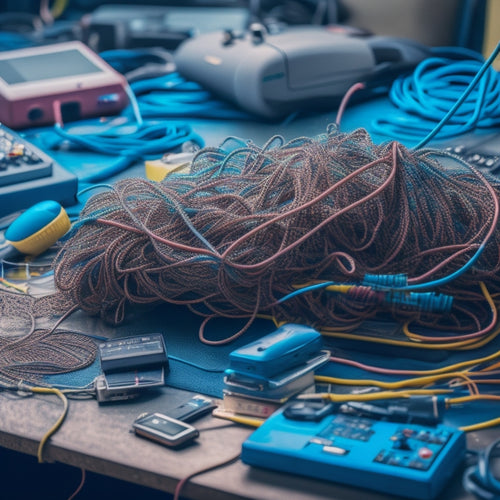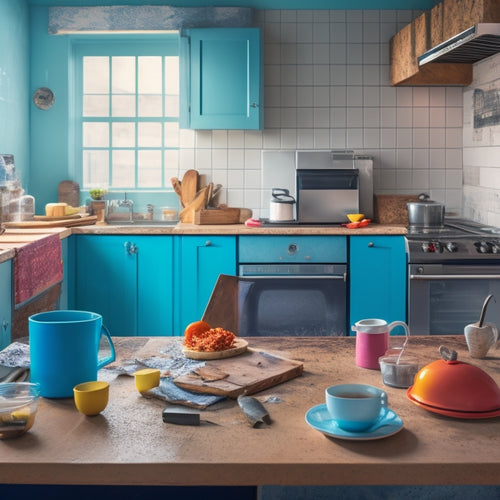
Nursery Closet Organization: Smart Ideas for Babies
Share
Effective nursery closet organization is key to creating a peaceful and functional nursery. Assess the available space and implement space-saving solutions, such as shelves, bins, and baskets, to optimize storage. Utilize creative closet organization methods, like wall-mounted shelves and hanging organizers, to maximize small spaces. Sort and categorize baby clothes by size, type, and season, and employ a 'one in, one out' policy to prevent clutter. By implementing these smart ideas, you can create a well-organized closet that supports the busy lives of new parents and fosters tranquility in the nursery. Discover how to take your nursery closet organization to the next level.
Key Takeaways
• Assess the available closet space to determine the most efficient storage solutions for baby essentials, maximizing every inch.
• Install shelves, bins, and baskets to categorize and store clothes, diapers, and toys, keeping them organized and easily accessible.
• Utilize vertical space with stackable containers and shelves to store items like onesies, sleepers, and blankets, keeping the floor clear.
• Implement a 'one in, one out' policy to prevent clutter and maintain a clutter-free closet, making it easier to find what you need.
• Designate specific areas for different types of clothing and items, such as a section for diapers, onesies, and sleepers, to promote a sense of calm and efficiency.
Maximizing Nursery Closet Space
To maximize nursery closet space, it is vital to assess the available area and utilize efficient storage solutions that cater to the unique needs of baby clothes and essentials.
Effective closet organization is essential in creating a functional and peaceful nursery environment. By implementing space-saving solutions, parents can optimize the available space, ensuring that every item has its designated place.
This includes installing shelves, bins, and baskets that are specifically designed for baby clothes, diapers, and accessories. A well-organized closet not only saves time but also reduces stress, making it easier to care for the baby.
DIY Nursery Organization Projects
Fifteen clever DIY nursery organization projects can transform a cluttered closet into a serene and functional space, providing parents with a sense of control and calm in the midst of chaos. With a little creativity, you can create a nursery that's both beautiful and organized.
Here are some inspiring ideas to get you started:
-
Upcycle an old dresser into a changing station with storage bins and baskets
-
Create a personalized nursery wall with cute decor ideas and eco-friendly storage solutions
-
Use budget-friendly nursery hacks like repurposing mason jars as storage containers
- Add personalized nursery touches with custom labels and decorative baskets
These DIY projects not only add a personal touch to your nursery but also provide functional storage solutions that are gentle on the environment.
Smart Storage Ideas for Small Spaces
Optimizing storage in small nurseries requires creative strategies that maximize every inch of available space, ensuring a clutter-free environment that promotes serenity and functionality.
Space-saving nursery solutions and clever storage ideas are essential for tiny nurseries. Consider creative closet organization methods, such as using wall-mounted shelves, hanging organizers, and compact storage bins.
Utilize vertical space with stackable containers and shelves, and make the most of corners with carousels or baskets. Small space hacks include using ottomans with storage, under-crib baskets, and multi-functional furniture.
Organizing Baby Clothes Efficiently
With a clutter-free nursery in place, attention can now shift to one of the most challenging tasks of baby preparation: organizing baby clothes efficiently, a feat that requires a thoughtful approach to storing, categorizing, and maintaining a vast array of tiny garments.
To achieve this, consider the following strategies:
-
Sorting clothes by size, type, and season to guarantee easy access and visibility
-
Utilizing baskets and bins to store and categorize items, keeping them off the floor and out of the way
-
Implementing a 'one in, one out' policy to prevent clutter buildup
- Designating a specific area for each type of clothing, such as a section for onesies and another for sleepers
Creating a Functional Nursery
Beyond organizing infant garments efficiently, a practical nursery necessitates a thoughtful and intentional approach to designing a space that accommodates the distinct requirements of a developing baby, from diaper changes to feeding and playtime.
A well-planned practical nursery design guarantees a smooth shift between these activities, fostering a feeling of tranquility and peace. When it comes to baby nursery decor, contemplate a neutral color scheme and simplistic furniture that can adjust to your baby's changing needs.
Integrate versatile pieces, like a changing table with storage, to maximize space. A practical nursery is not only visually appealing but also encourages a sense of order and effectiveness, enabling you to concentrate on what is most important - tending to your baby.
Nursery Closet Essentials Checklist
A well-organized nursery closet begins with a thoughtful selection of storage solutions and organizers that cater to a baby's unique needs, ensuring every item has a designated place and is easily accessible.
To create a functional and peaceful nursery, consider the following essential items:
- Shelves and storage units for baby essentials like diapers, toys, and clothes
- Bins and baskets for storing nursery decor items like blankets, pillows, and curtains
- Hooks and racks for hanging clothes, bags, and accessories
- Label makers and signs to identify storage containers and shelves
Transforming a Cluttered Nursery
Cluttered nurseries can quickly become overwhelming, making it challenging for parents to find what they need when they need it. Transforming the space into a serene and organized oasis is essential for a peaceful and functional nursery experience.
To achieve this, start by implementing decluttering tips, such as sorting items into categories and getting rid of unnecessary items. Incorporate creative storage solutions, like bins and baskets, to keep essentials within reach. Space-saving hacks, such as utilizing vertical storage options and multi-functional furniture, can also help maximize space.
Frequently Asked Questions
How Do I Keep Nursery Closet Organized After Baby's Arrival?
To maintain an organized nursery closet after baby's arrival, implement a clothing rotation system, utilizing storage solutions like bins and baskets, and perform seasonal updates to guarantee space efficiency and clutter-free storage.
Can I Use Nursery Closet Organizers for Toddler Clothes Too?
"Absolutely, nursery closet organizers can be repurposed for toddler clothes, utilizing space-saving techniques like adjustable shelving, bins, and baskets to store and organize outgrown baby items and accommodate growing toddler wardrobes."
Are Nursery Closet Organizers Worth the Investment for a Small Space?
When considering closet organizers for a small space, carefully evaluate the investment in relation to the benefits of space-saving solutions and budget-friendly options, ultimately determining if the investment results in a more functional and peaceful nursery environment.
How Often Should I Declutter and Reorganize the Nursery Closet?
To maintain a clutter-free nursery, consider scheduling regular decluttering sessions every 2-3 months, and allocate 30 minutes weekly for organization maintenance, ensuring a practical and stress-free space for your little one to thrive.
Can I Customize Nursery Closet Organizers to Fit My Personal Style?
When customizing nursery closet organizers, consider personalized designs that reflect your style, incorporating color coordination to create a cohesive look. Explore DIY options or stylish accessories to add a touch of elegance, ensuring a functional and beautiful space.
Related Posts
-

What's Holding You Back From Digital Simplicity?
You're struggling to achieve digital simplicity due to fear of overwhelm from technology anxiety, information overloa...
-

Kitchen Renovation Cost Estimates Made Easy
You're about to commence a kitchen renovation expedition, and getting a handle on the costs is essential to avoiding ...
-

7 Smart Pantry Storage Hacks for Home Cooks
You can turn your pantry chaos into a culinary haven with these 7 smart storage hacks. Start by maximizing vertical s...


